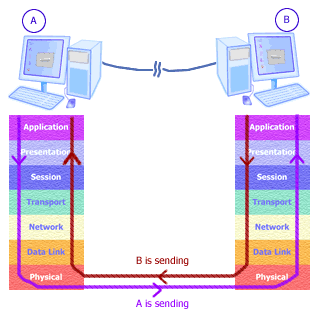Networking Guide : The OSI Reference Model
The International Organization of Standardization (ISO) defined
procedures for computer communications which was called Open
System Interconnection (OSI) Reference Model or OSI Model for
short. The OSI Model describes how data flows from
one computer to another computer in a network.

Picture. The OSI Model
When computers A and B communicate,
data travels across the 7-layered protocol stack.
The OSI Model is defined as a protocol stack that consists of
seven logical layers. Each layer has specific functions and handles a unique data
format. When two computers communicate, data flows from the
user-to-network interface (application) at the sending computer down through the protocol
stack to the connecting physical medium (i.e. cable, radio, or infrared) and up
through the protocol stack to the network-to-user interface
(application) at the receiving computer. When data flows from an upper
layer to a lower layer, it is converted to the lower layer data format
and a lower layer header is added to it. This process is called
encapsulation. Conversely, when
data flows from a lower layer to an upper layer, it is converted
to the upper layer data format and the lower layer header is discarded.
|